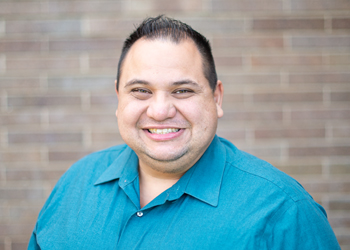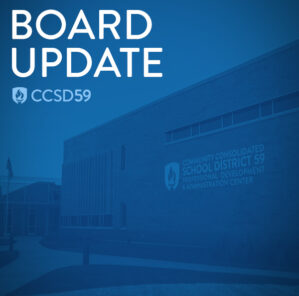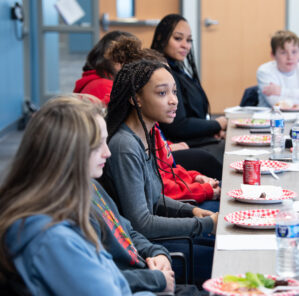MULTILINGUAL PROGRAMS
School District 59 is proud to offer a variety of language support services to meet the needs of our students who come to us with over 60 distinct languages at home. These home languages are a great asset to our district.
Please learn more about the Multilingual Programs in District 59 below. We are proud that our multilingual programs serve English Language Learners (ELLs) from various heritage backgrounds.
PROGRAMAS MULTILINGÜES
El Distrito Escolar 59 se enorgullece de ofrecer una variedad de servicios de apoyo lingüístico para satisfacer las necesidades de nuestros estudiantes que vienen a nosotros con más de 60 idiomas diferentes en casa. Estas lenguas del hogar son una gran ventaja para nuestro distrito.
Por favor, aprenda más sobre los programas multilingües en el Distrito 59 leyendo las siguientes preguntas. Estamos orgullosos de que nuestros programas multilingües sirven a estudiantes de inglés (English Language Learners)(ELL) de diversos antecedentes patrimoniales.


Frequently Asked Questions Preguntas frecuentes
District 59 offers an English Language Learner program for students who have another identified language and can benefit in getting support in developing the academic language skills required for school. All students enrolled in this program are supported with language while studying school subjects. These subjects include language arts, math, science, and social science.
The English Language Learner program has many different program types to meet the needs of a diverse group of learners. The programs include the Dual Language Spanish Program for students who speak Spanish, the Dual Language Polish Program for students who speak Polish, and the English as a Second Language Program for students who speak other languages.
The Dual Language Programs in District 59 are based on a dual language model that emphasizes the development of biliteracy and the goal is language proficiency and academic achievement in English and another language.
The ESL programs in District 59 provide support in a variety of ways, including resource services, self-contained classes, or integrated classes. A sheltered instruction approach is used to teach both language and content simultaneously.
All ELL teachers, whether they are ESL or Bilingual teachers, are trained to use teaching strategies that make language comprehensible and promote language development while using the grade level curriculum.
The ELL programs are located throughout the district and are provided either at the home school or at a nearby school where teachers can best accommodate the student’s needs.
El Distrito 59 ofrece un programa para aprendices de inglés para estudiantes que tienen otro idioma identificado y pueden beneficiarse al obtener apoyo para desarrollar las habilidades lingüísticas académicas requeridas para la escuela. Todos los estudiantes inscritos en este programa reciben apoyo con el lenguaje mientras estudian materias escolares. Estas materias incluyen artes del lenguaje, matemáticas, ciencias y ciencias sociales.
El programa para aprendices del idioma inglés tiene muchos tipos de programas diferentes para satisfacer las necesidades de un grupo diverso de estudiantes. Los programas incluyen el Programa de Lenguaje Dual de español para estudiantes que hablan español, el Programa de Lenguaje Dual de polaco para estudiantes que hablan polaco y el Programa de inglés como segundo idioma para estudiantes que hablan otros idiomas.
Los Programas de Lenguaje Dual en el Distrito 59 se basan en un modelo de lenguaje dual que enfatiza el desarrollo de la alfabetización bilingüe y el objetivo es el dominio del idioma y el logro académico en inglés y otro idioma.
Los programas de ESL en el Distrito 59 brindan apoyo de diversas maneras, incluidos servicios de recursos, clases independientes o clases integradas. Se utiliza un enfoque de instrucción protegida para enseñar tanto el idioma como el contenido simultáneamente.
Todos los maestros ELL, ya sean ESL o bilingües, están capacitados para usar estrategias de enseñanza que hacen que el lenguaje sea comprensible y promueven el desarrollo del lenguaje mientras usan el plan de estudios de nivel de grado.
Los programas ELL están ubicados en todo el distrito y se brindan en la escuela de origen o en una escuela cercana donde los maestros puedan adaptarse mejor a las necesidades del estudiante.
ELL stands for English Language Learners. English Language Learners are students who are learning English as their second language and need assistance in developing the academic language skills required for school. They need to acquire the social language, but more importantly the academic language.
ELL significa estudiantes de inglés (English Language Learners). Aprendices del idioma inglés son estudiantes que están aprendiendo inglés como segunda lengua y necesitan ayuda para desarrollar las destrezas académicas requeridas para la escuela. Necesitan adquirir el lenguaje social, pero lo más importante es el lenguaje académico.
English language learners make up 46% of our population in District 59. We have approximately 2,604 students identified as ELL in our Multilingual programs.
Los estudiantes de inglés forman el 46% de nuestra población en el Distrito 59. Tenemos aproximadamente 2,604 estudiantes identificados como ELL en nuestros programas multilingües.
During the registration process, all families receive a Home Language Survey. If another language is spoken in the home, we are required by the State to screen students for the ELL program. Students are recommended to be in the ELL program based on the results from the State required English language screener test. The test measures the student’s ability to listen, speak, read and write in the English language.
Durante el proceso de registro, todas las familias reciben una encuesta sobre el idioma casero. Si se habla otro idioma en el hogar, el Estado nos exige que examinen a los estudiantes para el programa ELL. Se recomienda que los estudiantes estén en el programa de ELL basado en los resultados de la prueba requerida por el idioma inglés. La prueba mide la habilidad del estudiante para escuchar, hablar, leer y escribir en el idioma inglés.
Dual language programs, like the one offered in District 59, are the only programs found to date that assist ELL students to fully reach and maintain high levels of achievement in the native language and English in all subjects through the end of schooling. Dual language programs include the strategic and sustained use of both English and the language other than English across the curriculum and require that a minimum of 50% of the instructional time be spent in the language other than English. In dual language programs students interact socially and academically in English and another language and develop both social and academic proficiency in two languages.
District 59 started their first dual language program in the 2009-2010 school year. The program started with a kindergarten class made up of 50% Spanish speakers and 50% English speakers. In dual language all students learn to read, write, listen, and speak two languages. Based on the success of the initial program, we have grown the program to be the model for bilingual services for our ELL students in the district.
Los programas de doble lenguaje, como el ofrecido en el Distrito 59, son los únicos programas encontrados hasta la fecha que ayudan a los estudiantes ELL a alcanzar y mantener niveles altos de logros en el idioma nativo e inglés en todas las materias hasta el final de la escolaridad. Los programas bilingües incluyen el uso estratégico y sostenido del inglés y el idioma que no sea el inglés en todo el currículo y requieren que un mínimo del 50% del tiempo de instrucción se gaste en el idioma que no sea el inglés. En los programas de doble lengua los estudiantes interactúan social y académicamente en inglés y en otro idioma y desarrollan habilidades sociales y académicas en dos idiomas.
El Distrito 59 inició su primer programa de lenguaje dual en el año escolar 2009-2010. El programa comenzó con una clase de kindergarten compuesta por 50% de hablantes de español y 50% de hablantes de inglés. En el lenguaje dual todos los estudiantes aprenden a leer, escribir, escuchar y hablar dos idiomas. Sobre la base del éxito del programa inicial, hemos ampliado el programa para que sea el modelo de servicios bilingües para nuestros estudiantes de ELL en el distrito.
The most comprehensive work done in this field is the research conducted by Wayne Thomas & Virginia Collier. Thomas & Collier studied the language acquisition of 700,000 English language learners in a longitudinal study from 1982 to 1996. They wanted to find out how long it took students with no background in English to reach native speaker performance (50th percentile) on norm-referenced tests. In addition, they looked at variables such as socioeconomic status, first language, programs used to learn English, and number of years of primary language schooling. In their study, Thomas & Collier found that the most significant variable in how long it takes to learn English is the amount of formal schooling students have received in their first language. They found that it typically takes between 5-9 years to learn another language academically (Thomas & Collier, 1997). It takes 5 years or less for students with a strong foundation in their native language and up to 9 years or more for students who were weak in their native language.
Our bilingual program in District 59, which now uses a dual language approach, has a content allocation plan to help grade level bilingual teachers know when to teach English and Spanish/Polish. It provides consistency between bilingual programs across the district and supports students in learning both English and another language.
Students in the ESL program receive support in their English development and that support is gradually released as the child acquires English and attains higher levels of English proficiency.
Every child is different and regardless of the type of ELL program, some students take less than 5 years to acquire English and others take longer.
El trabajo más completo realizado en este campo es la investigación realizada por Wayne Thomas & Virginia Collier. Thomas y Collier estudiaron la adquisición lingüística de 700,000 estudiantes de inglés en un estudio longitudinal de 1982 a 1996. Quisieron averiguar cuánto tardaron los estudiantes sin antecedentes en inglés para alcanzar el desempeño del hablante nativo (percentil 50) en las pruebas de referencia normativa . Además, analizaron variables como la situación socioeconómica, la primera lengua, los programas utilizados para aprender inglés y el número de años de enseñanza primaria. En su estudio, Thomas & Collier encontró que la variable más significativa en cuánto tiempo se tarda en aprender inglés es la cantidad de estudiantes de educación formal que han recibido en su primer idioma. Ellos encontraron que normalmente toma entre 5-9 años para aprender otro idioma académicamente (Thomas & Collier, 1997). Toma 5 años o menos para los estudiantes con una base sólida en su lengua materna y hasta 9 años o más para los estudiantes que eran débiles en su lengua materna.
Nuestro programa bilingüe en el Distrito 59, que ahora usa un enfoque de lenguaje dual, tiene un plan de asignación de contenido para ayudar a los maestros bilingües de nivel de grado a saber cuándo enseñar inglés y español / polaco. Provee consistencia entre los programas bilingües en todo el distrito y apoya a los estudiantes en el aprendizaje del inglés y otro idioma.
Los estudiantes en el programa de ESL reciben apoyo en su desarrollo en inglés y ese apoyo se libera gradualmente a medida que el niño adquiere el inglés y alcanza niveles más altos de dominio del inglés.
Cada niño es diferente e independientemente del tipo de programa ELL, algunos estudiantes toman menos de 5 años para adquirir Inglés y otros toman más tiempo.
All English Language Learners in K-12 must be assessed annually for English proficiency growth and academic progress. The ACCESS test is used to assess English language proficiency while the IAR test is used to assess academic achievement in English.
As a district we use a variety of academic measures to monitor progress of all learners. In order to make sure students are on track with their learning, we use local assessments to measure growth. The ELL teachers and classroom teachers work collaboratively to make sure students are making their growth targets for the year.
Todos los estudiantes de inglés de K-12 deben ser evaluados anualmente para el crecimiento de la competencia en inglés y el progreso académico. La prueba ACCESS se utiliza para evaluar el dominio del idioma inglés, mientras que la prueba IAR se utiliza para evaluar el rendimiento académico en inglés.
Como distrito usamos una variedad de medidas académicas para monitorear el progreso de todos los estudiantes. Con el fin de asegurarnos de que los estudiantes están en camino con su aprendizaje, usamos evaluaciones locales para medir el crecimiento. Los maestros de ELL y los maestros de Educación General trabajan en colaboración para asegurar que los estudiantes estén logrando sus metas de crecimiento para el año.
Students who can speak, read and write in their native language will learn English more quickly. You don’t need to teach reading twice. These native language skills transfer. A well-established native language will help children to learn a new language because they transfer what they know.
Parents can help by:
- Providing a strong language model at home within the language you feel most comfortable
- Reading stories to or with your child at home in the native language or English
- Using your native language to discuss the academic topics like math, science or social science, which are taught at school
- Being patient. Developing a second language for academics takes time, effort and understanding
- Taking your child to museums, theaters, libraries, and parks
- Becoming a part of your child’s educational team
- Keeping in contact with your child’s teachers and school
- Encouraging your child to participate in after-school activities
- Celebrating and acknowledging the growth your child makes in both languages
- Modeling the advantages of being bilingual
Los estudiantes que puedan hablar, leer y escribir en su lengua materna aprenderán inglés más rápidamente. No es necesario enseñar a leer dos veces. Estas habilidades de idioma nativo de transferencia. Una lengua nativa bien establecida ayudará a los niños a aprender un nuevo idioma porque transfieren lo que saben.
Los padres pueden ayudar a:
- Proporcionar un modelo de lenguaje fuerte en el hogar dentro del idioma que usted se sienta más cómodo
- Lectura de historias a o con su hijo en casa en el idioma nativo o en inglés
- Usando su lengua materna para discutir los temas académicos como matemáticas, ciencias o ciencias sociales, que se enseñan en la escuela
- Ser paciente. Desarrollar un segundo idioma para los académicos requiere tiempo, esfuerzo y comprensión
- Llevar a su hijo a museos, teatros, bibliotecas y parques
- Convertirse en parte del equipo educativo de su hijo
- Mantenerse en contacto con los maestros y la escuela de su hijo
- Alentar a su hijo a participar en actividades después de la escuela
- Celebrando y reconociendo el crecimiento que su hijo hace en ambos idiomas
- Modelar las ventajas de ser bilingüe
Our core purpose in District 59 is to prepare students to be successful for life. We believe that language and literacy, embedded in a rigorous and relevant curriculum, are integral components of this preparation. All students need fully developed capacities to read, write, speak, listen, and use language strategically and effectively. As our world becomes more global and connected, the development of language and literacy skills in both English and a second language provides significant educational and career advantages. The demographics of our district provide a rich environment to foster linguistic and cultural appreciation. Strong family and school connections build on the talents and assets that our students bring to school, and produce students who proudly identify themselves as bilingual and multicultural.
Nuestro propósito principal en el Distrito 59 es preparar a los estudiantes para tener éxito para toda la vida. Creemos que el lenguaje y la alfabetización, embebidos en un currículo riguroso y relevante, son componentes integrales de esta preparación. Todos los estudiantes necesitan habilidades plenamente desarrolladas para leer, escribir, hablar, escuchar y usar el lenguaje estratégica y efectivamente. A medida que nuestro mundo se vuelve más global y conectado, el desarrollo de las habilidades de lenguaje y alfabetización tanto en inglés como en un segundo idioma proporciona importantes ventajas educativas y profesionales. La demografía de nuestro distrito proporciona un ambiente rico para fomentar la apreciación lingüística y cultural. Las fuertes conexiones de la familia y la escuela se basan en los talentos y activos que nuestros estudiantes traen a la escuela y producen estudiantes que se identifican orgullosamente como bilingües y multiculturales.
Both Bilingual and English as a second language classrooms focus on the development of English language skills while learning school subjects such as language arts, math, science and social science. In a bilingual classroom, students who speak the same language work with a teacher who provides instruction in both the native language and in English. Bilingual classes are available for students who speak Spanish and Polish. An English as a second language classroom has children who come from different language backgrounds. Parents who speak Spanish or Polish may choose to put their child in an ESL classroom instead of a bilingual classroom. ESL classes are taught in English.
Students benefit academically by being in bilingual and ESL programs. Teachers use special teaching techniques to provide instruction. Lessons focus on learning vocabulary and developing reading and writing skills, while developing academic concepts. The teachers are providing students with opportunities to speak, listen, read and write in all subject areas. Teachers use a wide variety of visual aides and hands-on activities to ensure students’ understanding.
Los salones bilingües y de inglés como segundo idioma se enfocan en el desarrollo de las destrezas del idioma inglés mientras se aprenden materias escolares como artes del lenguaje, matemáticas, ciencias y ciencias sociales. En un salón de clases bilingüe, los estudiantes que hablan el mismo idioma trabajan con un maestro que provee instrucción tanto en el idioma nativo como en inglés. Hay clases bilingües disponibles para estudiantes que hablan español y polaco. Un salón de inglés como segunda lengua tiene niños que vienen de diferentes orígenes lingüísticos. Los padres que hablan español o polaco pueden optar por poner a su hijo en un salón de ESL en lugar de un salón de clases bilingüe. Las clases de ESL se imparten en inglés.
Los estudiantes se benefician académicamente al estar en programas bilingües y de ESL. Los maestros usan técnicas de enseñanza especiales para proveer instrucción. Las lecciones se centran en el aprendizaje del vocabulario y en el desarrollo de habilidades de lectura y escritura, al tiempo que desarrollan conceptos académicos. Los maestros están proporcionando a los estudiantes oportunidades de hablar, escuchar, leer y escribir en todas las materias. Los maestros usan una amplia variedad de ayudantes visuales y actividades prácticas para asegurar la comprensión de los estudiantes.




